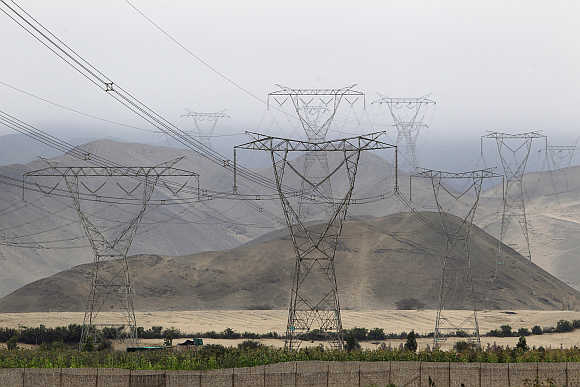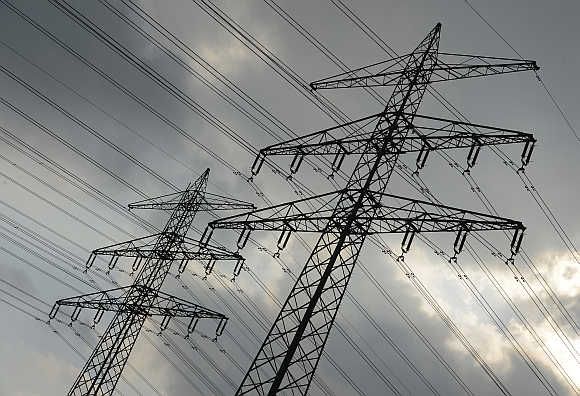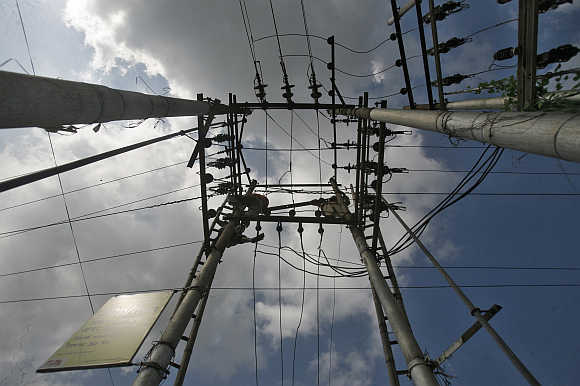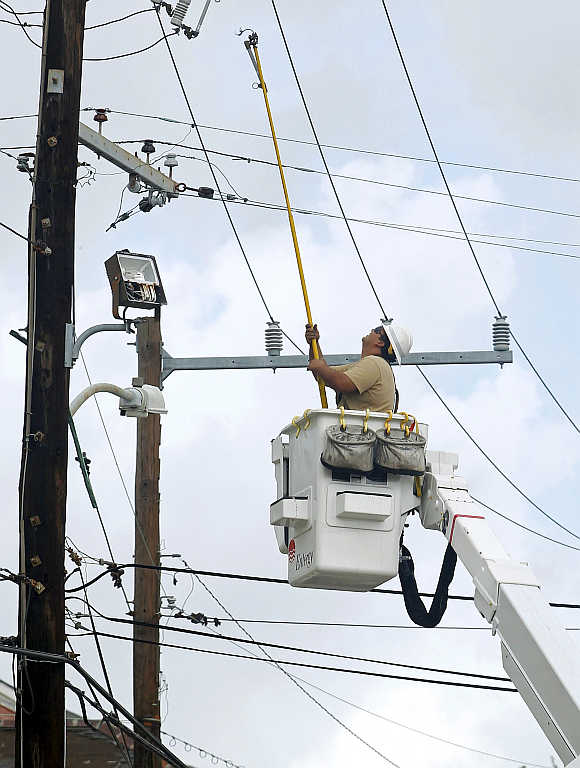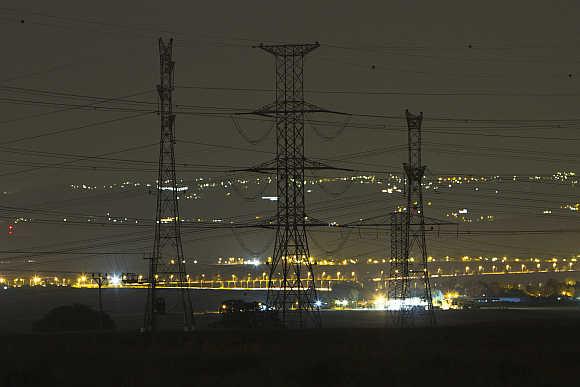 | « Back to article | Print this article |
How political wrangling is killing a power plant
When former prime minister Atal Bihari Vajpayee laid the foundation stone of NTPC's 1,980-Mw Karanpura power project in Bihar in 1999, he had asked opposition parties not to politicise issues related to India's development.
Over a decade later, in August last year, the then-power minister, Sushil Kumar Shinde, informed a ministerial panel on developmental issues surrounding projects that shifting the site, as proposed by the coal ministry to get the project going, was not feasible, as "it has become a political issue" because the "foundation stone was laid by a former prime minister of the National Democratic Alliance government".
The coal ministry last week floated a second Cabinet note on the matter after multiple attempts to resolve the contentious issue over the location of the project had failed. The issue has raised questions over the efficacy of developmental planning in the country. It has already given rise to massive inter-ministerial bickering between the coal and the power ministries and their flagship companies, Coal India and NTPC, respectively.
The controversy erupted when the coal ministry woke up in 2003, 15 years after the project site was first discussed in May 1988, and revealed that the site in the Chatra district in Jharkhand has an unbelievable six billion tonne of high-quality coal reserves.
Click NEXT to read more...
How political wrangling is killing a power plant
For comparison, this is roughly a tenth of the total 62 BT coal reserves held by Coal India, the world's largest coal miner. The ministry objected to setting up the project as the proposed power plant would sterilise the massive reserves. The proposal was to build a power plant, a water reservoir by creation of a dam for the plant, other infrastructure facilities and a township.
The ministry fears construction of the dam will restrict the operation of the Amrapali and other coal blocks around the area. The water reservoir will be a potential threat for inundation by flash floods of the nearby Piparwar and Magadh mines of Coal India - which are expected to yield 40 million tones of coal every year - as the catchment will be at a higher elevation than the mines. The heavy blasting in nearby mines could destabilise the dam in the future.
The dam would also submerge an area of 16 square kilometers, a bulk of which is forest land, apart from engulfing seven villages. The power evacuation corridor will hamper the operation of the large capacity draglines in the nearby mines. The ministry also fears that a large number of private dwellings and ancillary businesses would develop around the power plant, which would further sterilise the reserves.
Click NEXT to read more...
How political wrangling is killing a power plant
"The proposed location of the North Karanpura Super Thermal Power Plant needs to be reviewed irrespective of the efforts and money spent by NTPC or the Jharkhand government, when compared with the value and quantity of coal that will get sterilised, when it is already known that our coal resources are limited and need to be properly conserved," a senior coal ministry official says.
But, the power ministry and NTPC refuse to budge. They reject the "reserve sterilisation" argument, pointing out that the first coal seam under the project site is located below a depth of 300 metres.
"No mining in this country happens below 200 metres at present. So, where is the question of reserves being lost? These reserves are out of reach," a senior NTPC official says.
To add to the problem, NTPC has already invested around Rs 150 crore (Rs 1.5 billion) in the project, has got the necessary green clearances and has acquired land. Relocating the plant would throw back its efforts for development by three to four years, the company says.
While the coal ministry argues it had never given approval for the original location, as a way out of the logjam, it has proposed shifting the site to a new non-coal bearing location 15 km north-east of Chatra.
Click NEXT to read more...
How political wrangling is killing a power plant
It has also proposed increasing the project capacity to 4,000 Mw as the new location is scantily inhabited. Besides, the ministry has proposed developing the project as a joint venture between NTPC and Coal India where the coal miner would facilitate land acquisition and help secure statutory clearances.
According to the new plan, Coal India could take over the land already acquired by NTPC at the original location and reimburse its expenditure. NTPC, however, does not agree.
"Getting environmental and forest clearances and land acquisition are going to be very difficult in future. As a compromise, we had agreed to bring down the size of the project to 1,000 Mw at the original location. But, the coal ministry does not agree," the NTPC official says.
Reducing the project size was a recommendation of the B K Chaturvedi committee set up to look into the matter by a ministerial panel last year. With the two sides having failed to reach consensus on that suggestion, the matter is now being referred to the Cabinet again. This time, the coal ministry has sought to strengthen its case for relocation by drawing attention to the huge coal shortage in the country.
Click NEXT to read more...
How political wrangling is killing a power plant
India's coal imports, currently at 90 MT annually, are set to touch 200 MT by 2017 leading to a foreign exchange outgo of Rs 72,000 crore (Rs 720 billion) over the next five years. The ministry has also used the Chaturvedi committee's favourable recommendation of relocation in support of its argument.
But, what led the planners to overlook the huge reserve base under the original site and the collateral environmental and social damage of the proposed plant while charting out its development plan? When the project location was first discussed in 1988, minimal geological data, based on a single borehole, was available and the issue remained dormant for the next 15 years.
The site had received an "in-principle" approval during a meeting between NTPC and Coal India then. However, the sites for ash dumping, transmission corridor, township and other facilities were left undecided. The coal ministry's technical exploration arm, the Central Mine Planning and Design Institute, had remained non-committal about the location of the dam site.
The environment ministry had rejected the proposed location in 2001, two years after Vajpayee laid the foundation stone, in view of the adverse impact on the nearby protected forest area.
Click NEXT to read more...
How political wrangling is killing a power plant
In May 2003, CMPDI and Coal India informed NTPC that the project site houses coal reserves. According to the coal ministry, NTPC had agreed to shift the plant site in a meeting in July 2003. While this was to be followed up with site-specific investigations, NTPC did not proceed along these lines, the ministry says. Besides, the coal demand and availability scene had deteriorated drastically by 2005, making coal reserves a priced possession.
Experts say the Karanpura dispute highlights the failure of planning and coordination at the highest levels. "A decision on the matter should have been taken long ago by the coal and the power ministries, keeping the economics of the project in mind to decide whether the site is best suited for mining or power generation. It is unfortunate that the two ministries have failed to resolve the issue," Amrit Pandurrangi, senior director, Deloitte Touche Tohmatsu, says.
He suggests that a committee of independent experts be formed to propose a solution which should be binding on stakeholders involved.

